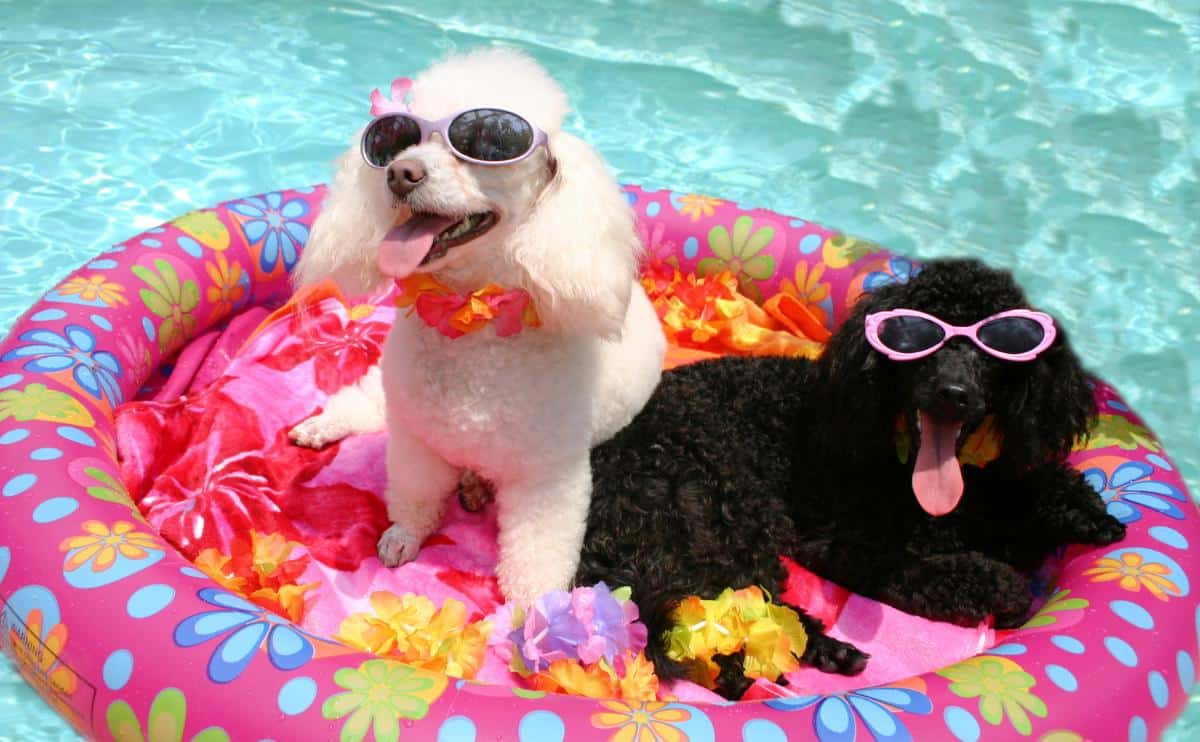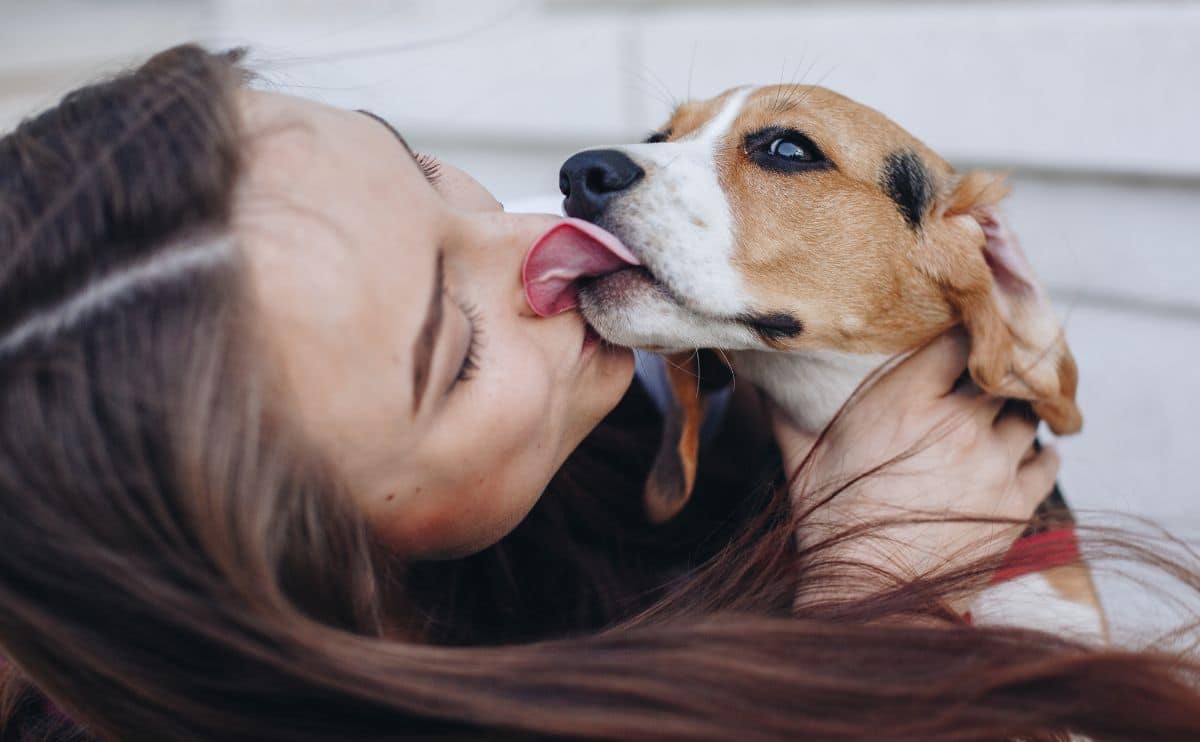Lost Your Dog? Here’s What You MUST Do In The First 24 Hours!
When you purchase through links on our site, we may earn a commission. Here’s how it works.

It happens to the best of us. We think our dog is behind us in the backyard, but then you notice he’s gone! Or you had someone working in your house, and the dog escaped out the door or garage. Some celebrities like Paris Hilton have even hired dog physics to predict their whereabouts. While you may not have to go that far (no pun intended), there are some basic things you can do to find your lost loved one. We’ll help you with the best way to find a lost dog, including how to get the word out to reunite with your pup, and share some tips to prevent them from darting off again.
Table of Contents
Find Your Lost Dog: Do These 10 Things Now!

The critical thing to do first to find a lost dog is to act fast. You know your dog best. Does he love other dogs and people? He may make friends with a nearby neighbor. Is he shy? He may be hiding under a car or in a bush. Knowing your dog gives you an idea of how to react.
Step 1: Start Searching Immediately
Dogs can cover much ground quickly, so don’t waste time! Begin searching in a radius around where your dog was last seen. Call their name calmly and listen for any movement or barking. Bring their favorite treats or a noise-related toy to get their attention.
Important: Don’t Chase After Them
As tempting as it is to try and run after your dog, they could think it’s a game and run faster and farther. Instead, drop down to their level, open your arms, and call their name happily. (Make sure you don’t use a growly “you’re in trouble” voice because most of us don’t want to go to someone upset with us.)
If this doesn’t work and your dog continues to run, follow him for as long as possible. Most dogs will not run in a straight line for an extended distance. Most dogs are found within a 2-mile radius of their home. Larger dogs in good health can run more than 5 miles, but most smaller dogs would be less likely to travel more than 0.5 miles.
Step 2. Alert Your Neighborhood
Knock on doors, ask neighbors, and get as many eyes looking as possible. Many dogs are found close to home, so enlisting help is crucial. If your dog has a favorite walking route, check there first.
Step 3: Search Your Neighborhood
Hop on your bike or in the car (a bike is better since you can access areas more easily than in a car) and cruise around the neighborhood where you last saw your dog. If you see a neighbor, mention your dog to them. Share the following information:
- Dog’s name
- Your name and contact information
- When the dog was last seen
- Where the dog went missing
- Breed and color (show a photo if you have one)
- What do you want people to do if they see your dog (call you, try to catch him, etc.)
Step 4: Use Social Media and Lost Pet Websites
Post in local lost pet Facebook groups, neighborhood apps (like Nextdoor), and lost pet websites. Include a clear photo, your dog’s name, location last seen, and your contact information. Be sure to mention any unique markings or behaviors.
Top 10 Things To Post When You Lose Your Dog
- Dog’s name
- Your name and contact information
- When the dog was last seen
- Where the dog went missing
- General area where you live (in case your dog returns to your neighborhood)
- Photos of the dog
- Breed and color
- What do you want people to do if they see your dog (call you, try to catch him, etc.)
- Reward (optional)
- Describe your dog and what he means to you (tugging at the heartstrings can help others relate)
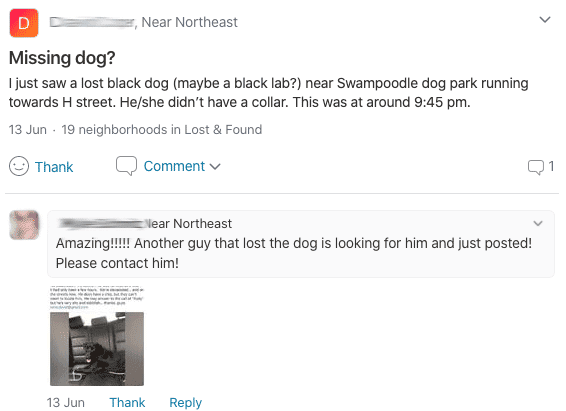
Be sure to share any updates about your dog’s sightings to help the community know the general area where your dog is located.
Step 5: Alert & Check Local Shelters and Rescues
Visit or call animal shelters, rescues, and vet clinics. Many shelters only hold stray animals for a few days before putting them up for adoption, so act quickly!
Contact local shelters, vets, etc., and share the above information. Check with them daily to see if your dog has been turned in. Notify the police of any incident reports involving your dog or if they see him out on patrol.
Step 6: Create and Distribute Flyers
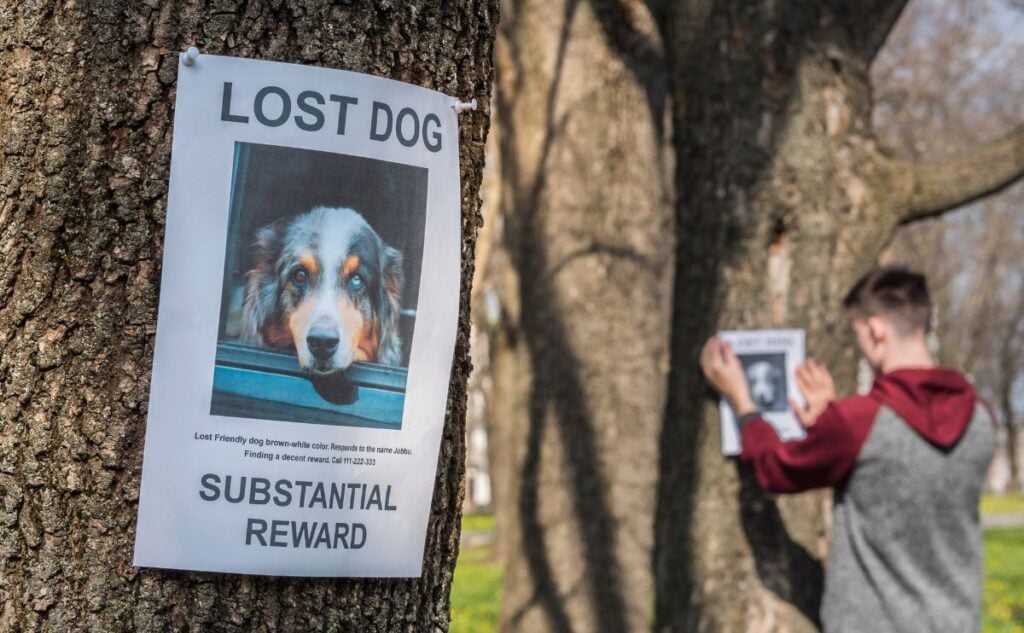
Print out large, easy-to-read flyers with a clear photo and your contact info. Post them at:
- Community centers and grocery stores
- Street corners and busy intersections
- Local vet offices and pet stores
One of the more effective tactics is the age-old “missing dog” flyer. Post them as quickly as you want.
9 Things Your Flyer Should Include:
- Dog’s name
- Your name and contact information
- When the dog was last seen
- Where the dog went missing
- General area where you live (in case your dog returns to your neighborhood)
- Photos of the dog
- Breed and color
- What you want people to do if they see your dog (call you, try to catch him, etc.)
- Reward (optional)
Don’t forget to take the flyers down after your dog is found.
Step 7: Leave Scent Items Outside
Place your dog’s bed, blanket, or a piece of your clothing outside your home. Dogs have an incredible sense of smell and may follow their scent back home.
Step 8: Watch Out for Scams
Unfortunately, scammers take advantage of desperate pet owners. Be wary of anyone who demands money before returning your dog. Always ask for proof (like a photo) before agreeing to meet anyone claiming to have found your pet.
Step 9: Don’t Be Afraid To Ask For Help!
Enlist as many family members and friends as possible to help immediately. Have people scour different parts of the neighborhood for the dog.
Step 10: Don’t Give Up!
Many dogs are found days, weeks, or even months after going missing. Keep searching, refreshing flyers, and checking online resources regularly.
When To Stop Looking For A Lost Dog
Deciding when to stop looking for a lost dog is a difficult and emotional choice. Remember, every situation is unique, and the decision to stop searching ultimately depends on your circumstances, your efforts, and any progress you’ve seen. Many lost dogs are successfully reunited with their owners even after extended periods. Keep utilizing all available resources and stay positive in your search efforts.
Pro Tip: Color Your Pet’s Fur
Dying your dog’s hair can help you identify it if it goes missing. Dogs with colored fur are also less likely to be stolen since they’ll have a unique feature. We recommend Rowan’s dog hair dye, a veterinary dermatologist-approved, vegan, petroleum-free hair dye formulated especially for pets. We had the opportunity to try it out, and here’s our experience.

My dog never looked so hip and fun. The kit came with three really cool colors, electric pink, purple, and teal color sticks that are creamy and easy to use. I decided to give it a whirl on my dog’s white tail, and the pink color was so vivid and totally cool that she looked like a rockstar. It lasted several days and was really easy to shampoo out. I think this is for light-colored areas, so it may not be for you if you have a dark dog. A super fun way to make your dog look edgy and easy to identify.
– Alanya W., Canine Journal
What Should I Do If I Find A Lost Dog?
You may be thinking, “I found a dog. What do I do?” Here are some tips on what to do in those situations:
- If the dog seems aggressive, call animal control or the police department. Do not approach the dog.
- If the dog seems friendly, capture and contain it in a safe manner. Try to leash the dog or confine him in a fenced-in yard or other safe space. Offer him fresh water.
- Check for identification on his collar. If you find identification, contact the owners and return the pet to them.
- If the dog does not have an ID tag, contact a local shelter, animal control, police department, or vet to have it scanned for a microchip.
- If there is no microchip found, you have a couple of options:
- Care for the dog while you search for its owner. Post fliers around town, post on social media, tell neighbors, notify local shelters and vets, etc.
- Take the dog to the local shelter, where the dog will be cared for and held. If no one claims the dog within a set amount of time, the dog will most likely be put up for adoption.
What Should I Do If I Find A Stray Dog?
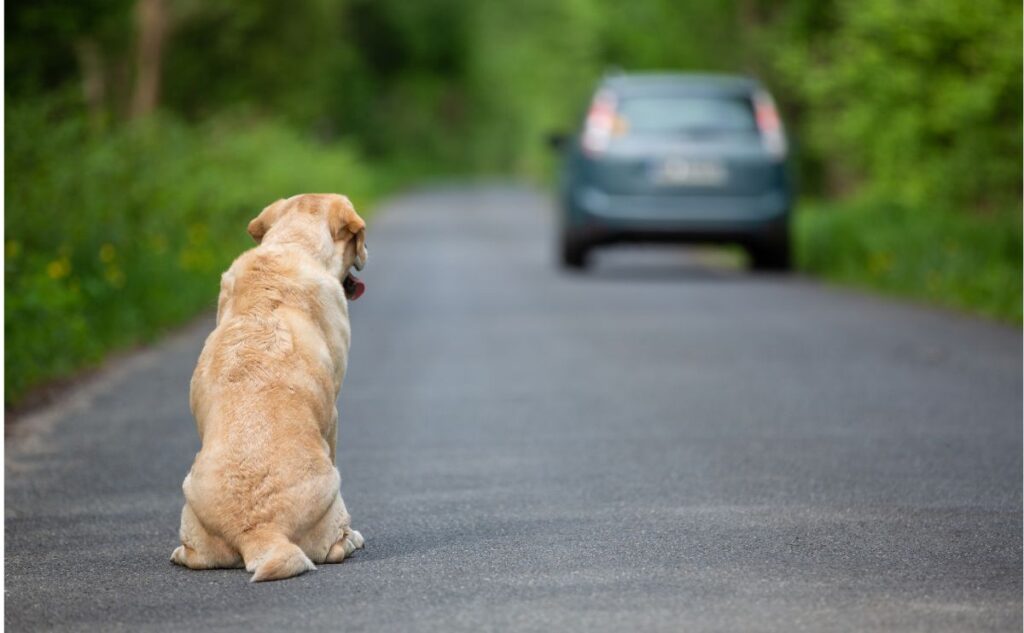
Trying to catch a dog? Specifically, how to catch a dog that won’t come to you? Catching a stray dog requires patience, caution, and empathy.
Here are steps to help you catch a stray dog safely:
- Assess the Situation: Evaluate the dog’s behavior from a distance. Is the dog friendly, scared, aggressive, or injured? This will help you determine your approach.
- Gather Supplies: Have treats, food, a leash, a slip lead or a humane trap (if needed), a secure crate, and gloves. Wear appropriate clothing to protect yourself from scratches.
- Choose a Safe Location: If possible, lure the dog to a safe, enclosed area like a backyard, garage, or quiet alley. This reduces the risk of the dog running into traffic.
- Lure with Food and Treats: Use a calm and gentle voice to entice the dog with food or treats. Toss treats near you to build trust. Gradually, get the dog to come closer to you.
- Use a Slip Lead: If the dog allows you to approach, calmly and slowly slip a lead over its head. This can prevent the dog from backing away or slipping out of a collar.
- Create a Safe Space: If the dog is wary of you, create a space where it can relax and eat. Place a bowl of food and water near the entrance of a secure crate. Once the dog is inside, close the crate door.
- Humane Traps: If the dog is extremely fearful or elusive, consider using a humane trap. Place food inside the trap and set it in a quiet area. Check the trap frequently and cover it with a blanket to reduce stress.
- Call for Help: If the dog is injured, aggressive, or in a dangerous situation, contact your local animal control or rescue organization for assistance. They have the experience and equipment to handle challenging situations.
- Gain Trust Slowly: Building trust with a stray dog takes time. Spend time near the dog without trying to catch it, allowing it to become comfortable with your presence.
- Seek Professional Help: If catching the dog proves difficult, seek help from professionals like animal control officers, animal rescue organizations, or experienced dog trainers.
- Check for Identification: Once caught, check for identification, such as a collar, tag, or microchip. This can help reunite the dog with its owner.
Remember, every dog is different, and patience is crucial. Approach cautiously and avoid sudden movements. Your goal is to ensure the safety and well-being of the stray dog while minimizing stress for both you and the dog.
Top 6 Ways To Avoid Losing Your Dog
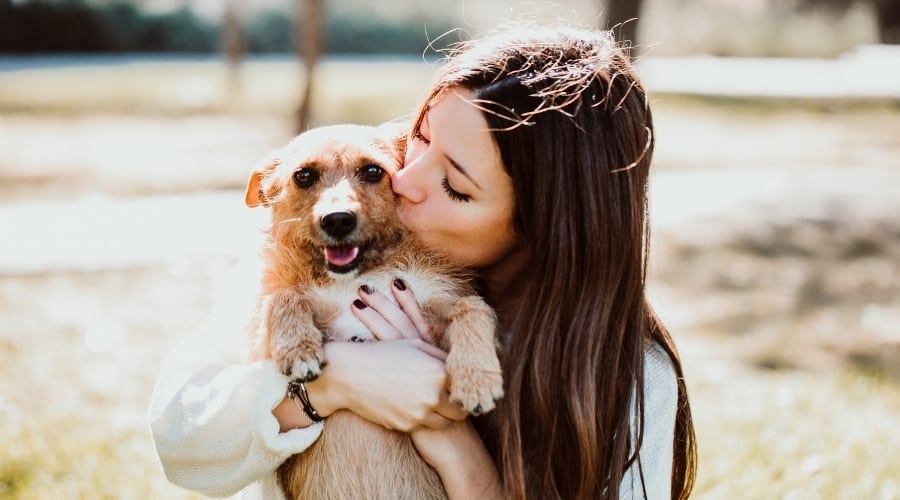
- Microchip your dog
- Put an ID tag on your dog’s collar
- Leash your dog when you’re outside
- Ensure your fence is secure and there are no gaps your dog can squeeze through
- Make sure everyone knows how to properly secure any gates (including young kids and visitors)
- Teach your dog basic commands like stay, wait, and back so when you open the door, he doesn’t try to dart outside
Top 9 Lost Dog Statistics You Won’t Believe!
- From an ASPCA survey:
- 15% of households had lost a dog or cat in the past 5 years
- 93% of lost dogs were recovered
- 49% of pet owners found their dog by searching the neighborhood, and 15% of the dogs were recovered because they were wearing an ID tag or had a microchip
- 6% of dog owners found their dog at a shelter
- According to Peeva (a pet technology company focused on improving information sharing for lost pets):
- 1/3 of pets become lost at some point in their lifetime
- Close to 10 million dogs and cats are lost or stolen in the U.S. every year
- Less than 23% of lost pets in the U.S. are reunited with their owners
- Out of 1,000 shelters, 4.3 million animals were handled, and 64% (about 2.7 million) animals were euthanized
- There are approximately 3,500 animal shelters in the U.S., which means roughly 9,450,000 to 9,632,000 pets are euthanized every year in the U.S.
These stats are pretty alarming and quite scary to read. More than 9 million pets are euthanized every year in the United States because they are lost, stolen, or for some other reason. This is a reminder for us all to do our best to keep our dogs in a safe, contained environment so they don’t join those 9 million dogs euthanized every year.
Did You Know? Some Pet Insurance Plans Cover Lost Pets
Did you know several pet insurance companies cover some costs associated with lost pets? Two providers in our pet insurance reviews come to mind: Figo and Fetch.
- Figo offers an Extra Care Pack as an add-on to your policy for an extra fee. This includes coverage for advertising, a lost pet reward, and $150 towards the loss of your pet.
- Fetch offers lost pet coverage with policies with a $15,000 annual limit or more. These customers include advertising costs, a reward for a stolen or lost pet, and reimbursement for the amount you paid for your pet if it is stolen, goes missing or isn’t found.
As always, we recommend microchipping your dog and putting an ID tag on its collar. That way, if your dog is lost but still in your area, a neighbor could call or bring it right back to your doorstep.
Have you lost a pet or found a lost pet? Share your experience in the comments!
